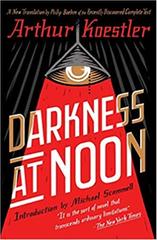 Darkness at Noon by Hungarian British author Arthur Koestler (1905-1983), published in 1940, follows an Old Bolshevik victim of Stalin's Great Purge--without mentioning the USSR or its leader by name. Stalin becomes "Number One," the Communists "the Party" and Nazi Germany "the Dictatorship." Protagonist Rubashov, an amalgamation of real purge victims, is arrested by the NKVD (called only the secret police) and subjected to three interrogations. Between these, Rubashov communicates with a neighboring prisoner via a tap code, who urges Rubashov not to confess to false charges. George Orwell credited Darkness at Noon as his inspiration to explore totalitarianism through fiction.
Darkness at Noon by Hungarian British author Arthur Koestler (1905-1983), published in 1940, follows an Old Bolshevik victim of Stalin's Great Purge--without mentioning the USSR or its leader by name. Stalin becomes "Number One," the Communists "the Party" and Nazi Germany "the Dictatorship." Protagonist Rubashov, an amalgamation of real purge victims, is arrested by the NKVD (called only the secret police) and subjected to three interrogations. Between these, Rubashov communicates with a neighboring prisoner via a tap code, who urges Rubashov not to confess to false charges. George Orwell credited Darkness at Noon as his inspiration to explore totalitarianism through fiction.Koestler, once a member of the German Communist Party, had grown disillusioned with the Soviet Union and Stalinism. He expressed this discontent in Darkness at Noon, written in Paris on the eve of World War II. His companion, the sculptor Daphne Hardy, hastily translated the manuscript from German to English and brought it to London while fleeing the Nazi invasion of France. The original German manuscript was believed lost until 2015, when a doctoral candidate discovered it in a Zurich library. This more complete version was given a higher quality English translation by Philip Boehm and an introduction by Koestler biographer Michael Scammell. It was published in September 2019 by Scribner ($17, 9781501161315). --Tobias Mutter

